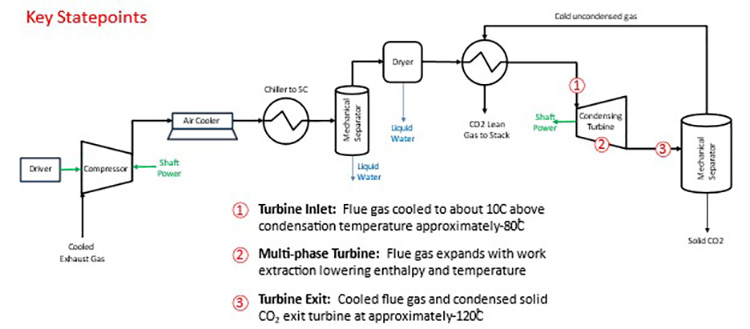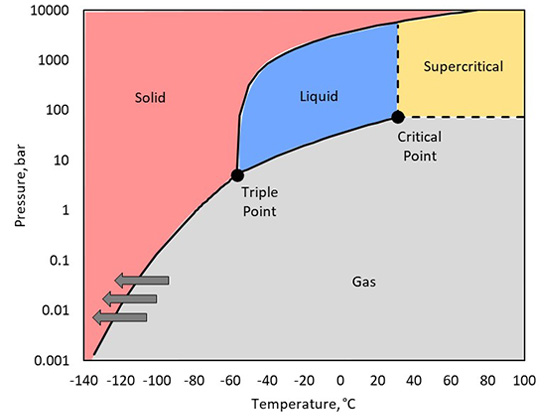Background
Mitigation of climate change effects is among the greatest challenges of our day. One of the promising tools for managing greenhouse gas emissions is the post-combustion capture and sequestration of CO2 from the flue gas of power plants and industrial processes. This project is investigating a novel technology for implementing a cryogenic CO2 capture system utilizing a multi-phase condensing turbine expansion to cool the flue gas to approximately -120 °C causing the CO2 to condense as solid dry ice (Figure 1). The CO2 condenses as solid dry ice because the partial pressure of CO2 in the mixture is below the triple point causing the phase change to be a de-sublimation directly from gas to solid (Figure 2). This solid CO2 can be mechanically separated from the remaining uncondensed flue gas and sent for sequestration. The innovative cooling process through turbine expansion overcomes a key challenge with previous cryogenic CO2 capture solutions in that it does not require condensation within a heat exchanger, thus avoiding critical challenges with the buildup of dry ice.

Figure 1: Simplified process diagram for cryogenic CO2 capture.
Approach
The project began with a literature and IP search which included the entire spectrum of potential CO2 removal technologies. This survey is being used to construct a techno-economic analysis framework. The evaluation of the system proceeded through the following steps:
Evaluation of the baseline system performance, component sizing, and preferred system architecture applicable to a natural gas fired 10 MWe reciprocating engine.
Completion of a 1-D real gas turbine design for a condensing cryogenic turbine to inform the system performance estimates and identify technology gaps and include the development of general-purpose axial turbine design tools applicable to future work.
Estimation of capital and operating costs for the selected system architectures and comparison of performance and cost against state-of-the-art CO2 capture systems using the techno-economic framework.
Creation of a technology development roadmap that accounts for technology gaps and risks identified during the project.

Figure 2: Simplified process diagram for cryogenic CO2 capture.

Figure 3: Assessment of conditions producing overall low interpolation error with higher values at the phase boundary as expected.
Accomplishments
An initial literature review revealed high quality reference cases for natural gas combined cycle (NGCC) power plants. One of these cases has been added to the project technoeconomic analysis scope to allow direct comparison to the reference. Fluid property models to handle real gas effects (Figure 3) in an axial turbine design tool and a method to account for gas to solid transition within a turbine for system modelling have been developed. Real gas tabular fluid properties interpolation methods are being paired with traditional loss model curves for axial turbines to enable a real gas turbine design tool. System modelling in Aspen will include solid CO2 formation and a techno-economic framework to assess both system performance and costs compared to competing technologies.
